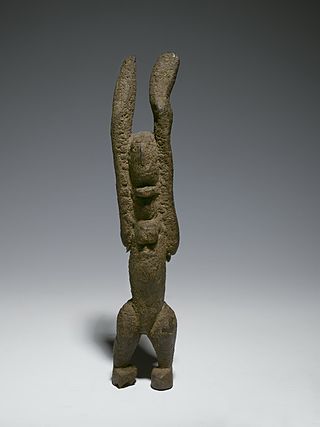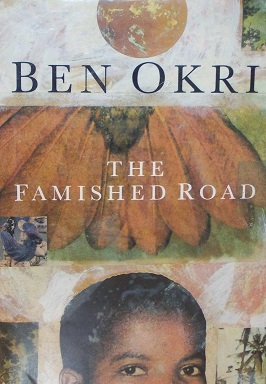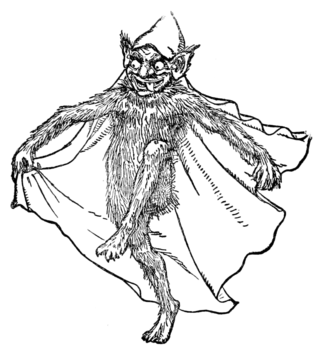By Country
Benin
Mythology from Benin mostly comes from Dahomey. Several gods exist in the Dahomean Religion, with each having its own mythology. Myths of the Fon and Ewe people feature Aziza, fairy like creatures who live in the forest. According to legend, they provide good magic for hunters, and are also known to have given practical and spiritual knowledge to people. Common descriptions of Aziza people state that they are hairy people, and are said to live in anthills and silk-cotton trees. [3]
Gambia
In the Gambia, most folklore proposes the existence of Ninki Nanka; descriptions of this creature vary, but most contend that the animal is reptilian and possibly dragon-like. The Ninki Nanka lives in the swamps. It attracted mainstream attention when in 2006, a group of "dragon hunters" from the Centre for Fortean Zoology (CFZ) went to Gambia to investigate the Ninki Nanka and take testimony from those who have claimed to have seen the mythical creature. [4]
Ghana
In the Ewe folklore of Togo and Ghana, the Adze is a vampiric being that takes the form of a firefly, though it will transform into human shape upon capture. When in human form, the adze has the power to possess humans. In firefly form, the adze would pass through closed doors at night and suck blood from people as they slept. The victim would later fall sick and die. [5]
A similar mythology from the Akan people of southern Ghana, as well as Côte d'Ivoire, Togo [6] and 18th century Jamaica features creatures called Asasabonsam. These are vampire like beings who live in the forest and feed on people that wander around their home. An Asasabonsam is said to have iron teeth, pink skin, long red hair and iron hooks for feet. It lives in trees, attacking from above while in its humanoid form. It possesses bat-like features, including wings. [7] [8]
Obayifo is a vampire/witch-like mythological creature from the folklore of the Ashanti. In Ashanti folklore, obayifo are very common and may inhabit the bodies of any man or woman. They are described as having shifty eyes and being obsessed with food. When travelling at night, they are said to emit a phosphorescent light from their armpits and anus. The obayifo is similar to the Asiman of the Dahomey people, a creature that can shapeshift and fly, turning itself into a ball of light and hunting for prey in the night sky. [9]
Anansi, a trickster spider god from the Akan mythology, is also prevalent. He is often depicted in folktales interacting with the Supreme Being and other deities who frequently bestow him with temporary supernatural powers, such as the ability to bring rain or to have other duties performed for him. Some folkloric traditions portray Anansi as the son of the Earth Mother Asase Yaa. In others, Anansi is sometimes also considered an Abosom (lesser deity) in Akan spirituality, despite being commonly recognized as a trickster. [10] [11]
Mali
Malian mythology comes from a variety of ethnicities; among the Dogon people, Nommos are usually described as amphibious, hermaphroditic, fish-like creatures. Folk art depictions of Nommos show creatures with humanoid upper torsos, legs/feet, and fish-like lower torsos and tails. Nommo are the first living creatures. According to Dogon Astrology, the Nommos were inhabitants of a world circling the star Sirius. The Nommos descended from the sky in a vessel accompanied by fire and thunder. After arriving, the Nommos created a reservoir of water and subsequently dove into the water. The Dogon legends state that the Nommos required a watery environment in which to live. [12] [13]
Nigeria
The mythology of Nigeria is diverse because of the various ethnic groups that share the country. Elements of Yoruba mythology include the Orisha, a pantheon of gods who are also venerated in the Candomble, Santeria, and Haitian Vodou religions in the African diaspora.
Another category of supernatural entity in Yoruban mythology is the Abiku, children from the spirit world who die before reaching puberty. Abiku also refers to the spirits which historically are said to inhabit trees. [17] [18]
Egbere are malevolent spirits that inhabit bushes and forests. They are seen at night. An Egbere is said to be short, own a small mat, and cry all the time. According to legend, anyone who takes the mat from it will become rich. [19] [20]
In the mythology of the Igbo people from southeast Nigeria, Ogbanje are evil spirits that are disguised as children, spirits who cause misfortune and grief. [21] It was believed that within a certain amount of time from birth (usually before puberty), the ọgbanje would deliberately die and then be reborn into the next child of the family before then repeating the cycle, causing much grief. The evil spirits are said to have stones called Iyi-uwa, which they bury somewhere secret. The Iyi-uwa serves as a talisman for the ọgbanje to return to the human world and to find its targeted family; destroying the Iyi-uwa cuts the connection of the ogbanje and frees the family from the torment. [22] [23]
In northern Nigeria, among the Kanuri people of the Borno Emirate in the Lake Chad region, beliefs of a form of werehyenas referred to as bultungin which translates into "I change myself into a hyena" exist. [24] It was once traditionally believed that one or two of the villages in the region was populated entirely by werehyenas, [25] such as Kabultiloa. [26]
Mami Wata are spirits or creatures that dwell in rivers and oceans. They are often described as mermaid-like figures, with a woman's upper body (often nude) and the hindquarters of a fish or serpent. In other tales, Mami Wata is fully human in appearance; though never human. The existence and spiritual importance of Mami Wata is deeply rooted in the ancient tradition and mythology of the coastal southern Nigeria. Mami Wata often carries expensive baubles such as combs, mirrors, and watches. Large snakes frequently accompany them, wrapping themselves around them and laying their heads between their breasts. Other times, a Mami Wata may try to pass as completely human, wandering through busy markets or patronising bars. She may also manifest in a number of other forms, including as a man. [27] [28] [29]
Tortoises (Yoruba: Ijapa, Igbo: Mbeku) are also part of Nigerian mythology, as they are considered to be tricksters and feature heavily in folklore of southern Nigeria while the hare (Hausa: Zomo) features heavily in northern Nigeria. [30] [31] [32]
Senegal
In the mythology of the Wolof people and Lebou people, Yumboes are supernatural beings who closely resemble European fairies. They are also called Bakhna Rakhna, which literally means good people. They are completely of a pearly-white colour. They are sometimes said to have silver hair. They stand about two feet tall.
The Yumboes live beneath the Paps hills and come out to dance in the moonlight. They feast on large tables, waited on by servants who are invisible except for their hands and feet. Yumboes eat corn, which they steal from the humans and fish. They invite both natives and foreigners to their feast. [33] [34]







